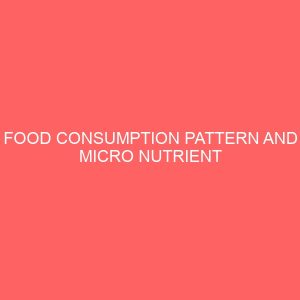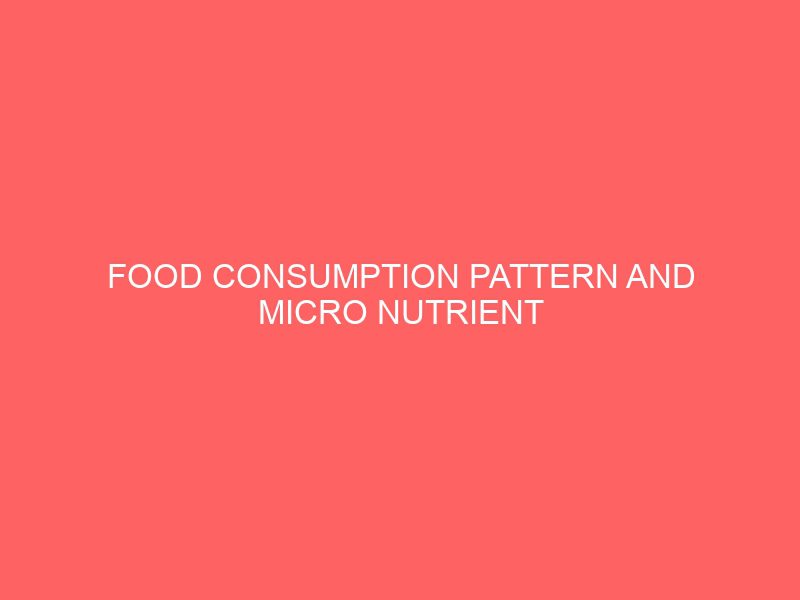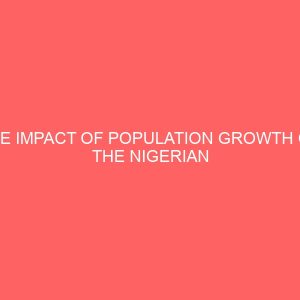Description
CHAPTER ONE
1.0 INTRODUCTION
This research is on Food consumption pattern and micro nutrient intake of mothers in Imo state. Nutrition is the science of food, nutrients and other substances, their action, interaction and balance in relation to health and disease and the processes by which the organism ingests, digests, absorbs transports, utilizes and excretes food substances.
The development of nutrition made food to be recognized as the fundamental source of nutrients. Food and nutrition are basic human rights because they are necessary for human development.
Malnutrition is the major contribution to illness and diseases in the world. This includes risk factors related to under nutrition, excess consumption of certain diet components (carbohydrates, fat, etc) and low consumption of other food items like fruits and vegetables. Rural dwellers food consumption pattern depends on many factors intervention into the life patterns of the community to which they belong. These factors affect food availability and how each food could be processed and stored.
Food consumption patterns can be defined as the recognizable ways of eating foods rural dwellers tend to adhere to their old eating patterns rather than venturing to seek new and more proper eating habits. In order to maintain healthful diets, a variety and balance of foods from all food groups and moderate consumption of all food items is very important.
Variety in diet implies choosing a number of different foods within any food group, rather than eating the “same old thing” day after day. Food consumption patterns has been observed to be influenced by socio-economic factors including sex, income, occupation, type of house and source of cooking energy, food consumption patterns of the mother prior to conception during pregnancy and lactation affects the reproductive cycle and health of the newborn infant. A mother with poor food consumption patterns has the risk of delivering a baby that is physically and mentally handicapped. Wright and Sims (1987) assert that many complex interacting systems affect man’s food consumption pattern and his consequent state of health. They further explained that natural environment (climate, topography soil conditions etc) determines what food can be produced. The man made environment (technological developments for processing, storing and distribution of food) affects what food will be made available for consumption.
Proper and adequate food consumption patterns is the instrument for achieving other rural developmental goals, most especially those connected to reduction in child mortality and improvements in material health. Primary educational enrolment and achievement, gender equity and the capacity of resist disease, in order to be healthy and active women need to have food in adequate quantity, quality and variety in order to meet energy and nutrient. Consumption patterns of the mother prior to conception and during pregnancy and lactation affects the reproductive cycle and health of the newborn infant. A mother with poor food consumption patterns have the risk of delivery a baby that is physically and mentally handicapped.
Adequate food plays an important role in rural development activities. It ensures their capacity to embark on livelihood activities that is sustainable.
1.1 OBJECTIVES
Broad Objective
- To assess the food consumption pattern and micro nutrient intake of mothers in Imo State Local Government Area Lagos.
Specific Objectives
- To assess the nutritional status of mothers in Imo State L.G.A
- To investigate, measure and assess the food pattern of mother in Imo State L.G.A.
- To assess the micronutrient intake of mothers in Ojo L.G.A.
1.3 JUSTIFICATION
Malnutrition remains an existing problem among Nigerians especially women and children. Malnutrition could be due to lack of food or socio-cultural factors of people. This study will throw light on the following
- It will add to our knowledge on the relationship between nutrition of people and the socio-economic characteristics of the people
- The actual or real causes of malnutrition in Nigeria.
1.4 RESEARCH QUESTIONS
- What is pattern of women activity
- What is the current food consumption pattern of mothers in Imo State L.G.A
- What is the socio-economic and demographic characteristics of women in Imo State LGA.
- To determine the relationship between their food consumption patterns and their environmental health condition.
1.5 PROBLEM STATEMENT
Malnutrition is a poor condition of health, caused by a lack of food or a lack of the right type of food. Many Nigerians are plagued with malnutrition. Malnourished Nigerians was as high as 24% in the rural area and 26% in the urban area.
It is important to know the reasons for the existing poor nutritional state of population could it be due to
1. Lack of nutritional awareness of the people
2. Un-availability of nutritional foods
3. Thus this study will examine the food consumption patterns and micro nutrient intake of mothers in Imo State LGA Lagos.
1.6 Limitations of study
- Some of the questions asked in the questionnaires were felt to be personal like how much their annual income.
- Some of the women could not spare time to fill the questionnaires
- Some were illiterates and so could not understand the questionnaires







